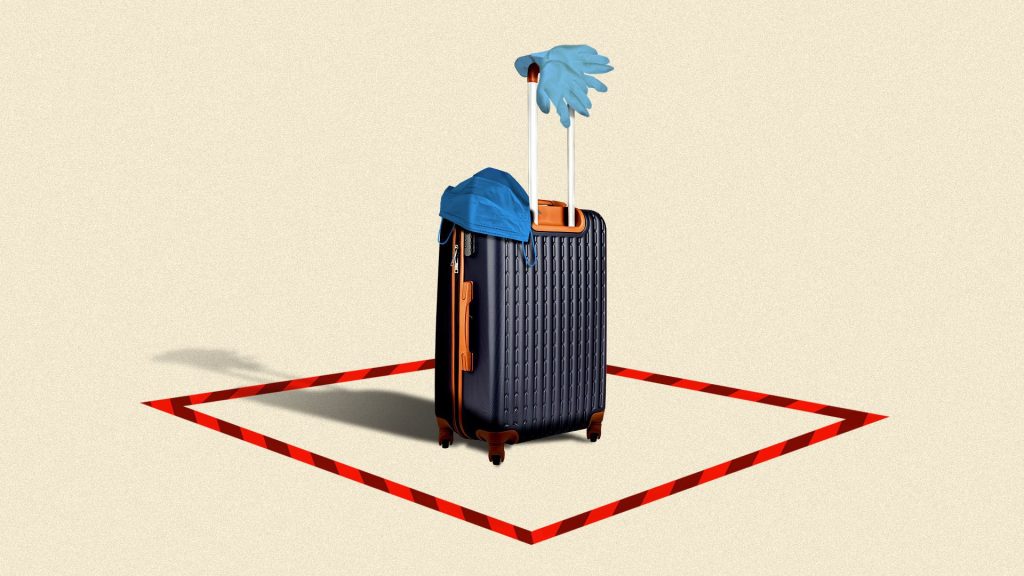Whenever you’re ready to fly again, be prepared: air travel after the coronavirus will look and feel a lot different from the last time you boarded a plane.
The big picture: With passenger traffic down 95% during the height of the pandemic, airlines have all but given up on trying to salvage the lucrative summer travel season. The global industry expects to lose $314 billion this year, and airline executives say it could be two to three years before air travel recovers to pre-crisis levels.
In the meantime, pack your patience along with your face mask: everything is going to take longer.
- Expect new procedures for everything from luggage check-in to security clearance and boarding.
- You might even need to have your blood tested to prove you’re in good health before boarding.
- “9/11 changed travel completely with added security checks and longer check-in times. The impact of COVID-19 on air travel will be even more far-reaching,” says airline consultant Shashank Nigam, CEO and founder of SimpliFlying, in a blog post.
The big question: How much hassle will people tolerate, or will they avoid flying altogether?
What’s happening: Right now, flights are practically empty, making it easy to spread out for social distancing.
- Despite a $50 billion taxpayer-funded relief package, airlines say they’ll need to shrink to match lower demand. As they consolidate flights, planes will fill up again.
- Jet Blue Airways and United Airlines say they’ll require passengers to wear face masks, and others say they’ll make them available. (Flight crews are already wearing masks on many airlines.)
- U.S. Rep. Peter DeFazio (D-Ore.), chair of the House Transportation and Infrastructure Committee, wants the FAA to make masks mandatory for everyone.
- Airlines also say they’ll limit ticket sales so that middle seats can remain open.
Masks and social distancing are only the beginning. In a new report, “The Rise of Sanitised Travel,” SimpliFlying anticipates dozens of ways air travel might change in the coming months and years. Some examples:
- Online check-in: Besides choosing their seat or paying for checked bags, passengers might also need to upload a document to confirm the presence of COVID-19 antibodies before they fly.
- Airport curbside: Passengers could be required to arrive at least four hours ahead of their flight, and pass through a “disinfection tunnel” or thermal scanner to check their temperature before being allowed to enter the airport.
- Check-in and bag drop: New touchless kiosks would allow passengers to check in by scanning a barcode, or using gestures or voice commands. Agents would be behind plexiglass shields, and bags would be disinfected and then “sanitagged.”
- Health check: Passengers would undergo a health screening, and potentially even have their blood tested. In April, Emirates became the first airline to conduct rapid on-site COVID-19 testing of passengers before boarding.
- Security: Each carry-on bag and security bin would be disinfected when entering the X-ray machine, using fogging or UV-ray techniques, then “sanitagged.”
- Boarding: Passengers would need to be present an hour before departure, maintain social distancing in the gate area and board only when they receive individual notifications on their smartphones to prevent crowding in the jet bridge.
- On the plane: The pre-flight safety video might include sanitation procedures, as passengers wipe down their seats and tray tables. In-flight magazines will be removed, seatback pockets emptied, and passengers will likely use their own devices to watch videos. An in-flight janitor might keep lavatories and other high-touch areas disinfected after passenger use.
What to watch: Designers like Italy’s Aviointeriors are contemplating new seating arrangements or barriers between seats to minimize the risk.
- Imagine the middle seat facing the other way, for example, with clear barriers between passengers.
The bottom line: If it seems hard to fathom, remember this: we never imagined we’d have to take off our shoes before passing through airport security, either.
